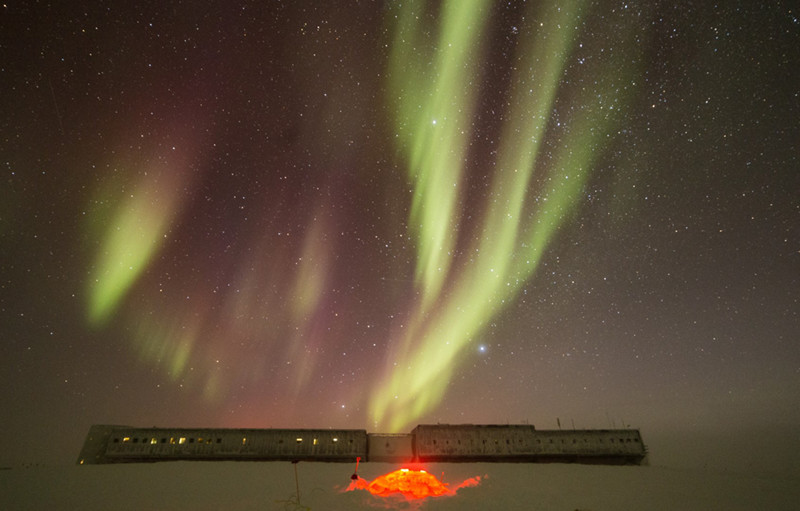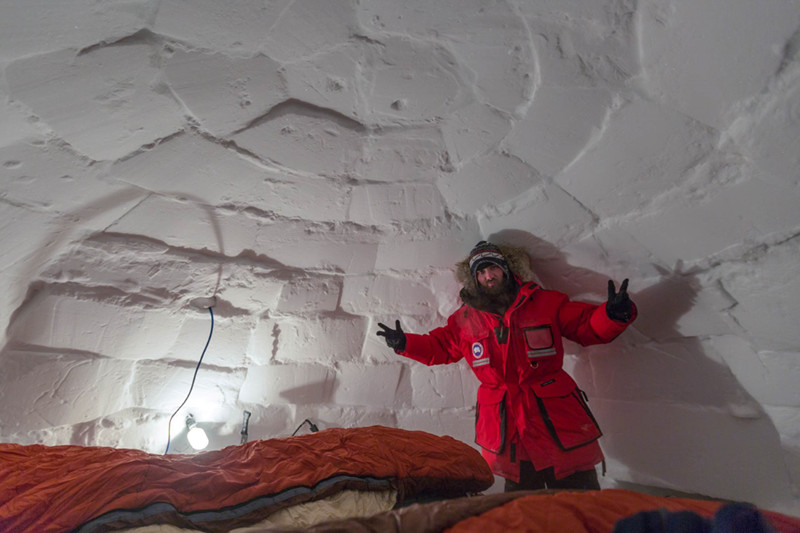
Photo Credit: Hamish Wright
|
The igloo, signed by its construction team, glows blue and green, with the red lights from the South Pole telescope off in the distance.
|
House of Ice
Five South Pole residents spent a night in an igloo they built on their off hours in the dead of winter.
By Michael Lucibella, Antarctic Sun Editor
Posted September 13, 2016
During the months-long, dark and frigid winter at the South Pole, members of the station’s winter crew spend their free time in lots of ways. Some read books, others watch movies or work on art projects.

Photo Credit: Christian Krueger
The Igloo team enjoys a hot Thai curry inside their construction after its completion. From left to right Christian Krueger, Hamish Wright, Darby Butts, John Rossero and Joshua Neff.
Still others build igloos.
“Josh, myself and the others were bandying about the idea since early in the season,” said Hamish Wright, the station’s physician. “I'm not sure who came up with it from the get-go, but we were all keen to sleep outside… This way it gave us a bit of a taste about what the true explorers experienced.”
For a week in August, working after the ends of their nine-hour shifts and on the weekends, he and four other wintering residents at the National Science Foundation’s Amundsen-Scott South Pole Station spent their free time outside—where winds gusted to 40MPH, breaking a few daily wind-speed records and bringing temperatures below -100 Fahrenheit, with the wind chill—cutting, chopping and stacking blocks of snow to assemble their icy structure.
“It is simply great fun to be part of such an ambitious, challenging project and I wanted to see how we would perform in such a hostile environment,” said Christian Krueger, a scientist with the IceCube Neutrino Observatory.

Photo Credit: Christian Krueger
Illuminated with red-colored headlamps, the igloo glows in front of the Amundsen-Scott South Pole Station and under the colorful aurora australis.
The project was completed in accordance with an existing procedure on recreational and off-site travel that lists the requirements and protocols, for traveling away from the station—including for overnight travel and camping--for all South Pole personnel.
The 46-person crew at South Pole remains at the station during the Southern Hemisphere’s winter to insure that the station remains at peak operational condition and that large experiments, such as IceCube continue, continue to gather data. In the case of IceCube that is to record the passage of elusive subatomic particle called neutrinos.
The five-person igloo team included Wright, Krueger, Joshua Neff, a maintenance specialist at the station, John Rossero, who works at the station’s power plant, and Darby Butts, food services supervisor.
Using tools ranging from an electric chainsaw to a homemade snow knife forged out of a piece of scrap steel, they cut 95 blocks of ice out of the hardened snow around the igloo site. It was a harsh week to be working outside. With the sun still below the horizon and no moon, the only light they had to work with was from their small headlamps.
“Working on it had its good days and not so good days,” Rossero said. “Standing out in pitch black darkness equipped only with a head lamp and the will to succeed during 20-plus knot winds driving snow and bitter cold for me just added to the overall experience.”
But the harsh, moonless conditions yielded a spectacular sight for the group.
“On the first evening the auroras were so bright and beautiful that everyone stopped and laid down to admire them,” Neff said. “You could actually see the horizon in otherworldly green.”
The team wanted to use authentic Inuit building techniques that could protect them from the cold. But , collectively, the team had almost no real experience building an igloo, so Neff spent the day before starting watching documentaries about the native cultures in the Arctic to glean what he could about how they built their igloos. Using what they learned, the team designed a snow dome about 13 feet across and nine feet high, with cold trap dug out inside to catch and divert the cold air inside the igloo.
“That evening we had a planning meeting because it is difficult to communicate outside in hoods, balaclavas, winds and differing accents,” Neff said.

Photo Credit: Christian Krueger
Hamish Wright Stands up inside under the 9-foot ice dome. Using the thick sleeping bags, the team spent a night in their igloo.
Over the week of dedicated work, the snow dome took shape. Throughout the process, safety in the wintry conditions was paramount.
“Everything was conducted with extreme care regarding safety, and I am happy to say no injuries or frostbite were accrued during this process,” Neff said.
With each evening of work, the igloo grew until they capped off the dome and finished the entrance way.
“After putting in more than 100 man-hours during our free time over the course of a week, it was hugely rewarding to see the final product,” Butts said.
“It was a great moment when all five of us took part in shaping the keystone that would finally complete the igloo's outer structure,” Krueger said. “It was truly amazing to see how stable our igloo turned out (I was able to stand on it) and how ‘warm’ it was inside compared to the outside.”
The heat trap they built into the design worked. Inside the completed igloo the temperature rose to a comparatively balmy 10 degrees Fahrenheit, heated by the team’s warm-from-work body heat.
“[It was] surprisingly more comfortable than I expected,” Butts said. “We ate dinner, played cards, joked around and I got a great night’s sleep.”
After a few hours, the temperature cooled to about -18 Fahrenheit, at which point the team crawled into their thick sleeping bags and bed down for the rest of the night.
Neff added that just like during construction, safety was the top concern for the team. “Due to the high winds, every two hours one of us had to wake up to check and make sure our door hadn’t drifted in.”
Other members of the winter crew were impressed with the final construction. A few even spent a “night”—a relative term in a place where the sun sets for approximately six months-in the igloo themselves.
Despite the team’s hard work, the igloo could not be a permanent addition to the South Pole station. Any changes to the topography on the otherwise flat polar plateau can alter how wind blows around the station, potentially causing excess snow accumulation.
“It was sad day, a mere week after completion, that we squished our accomplishment,” Neff said.








